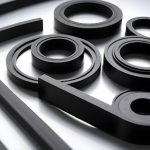Introduction
Industrial machine operations are as robust as the sealers that stand behind them. The sealers could be acclaimed as pillars of reliability and efficiency. Their scope in this respect goes way beyond the presumption of a failure occurring; instead, they are integral items that assure top performance, reduced downtime and safety concerns. From an extensive overview of sealing solutions for the industry to application of the various types and trouble free industry embrace of the best practices the whole guide’ dat for sealing solutions for industrial machinery is multifacet and it is even more.
The Role of Sealing Solutions in Industrial Device Ensures Safety, Efficiency, and Cost Effectiveness.
Sealing solutions are company omissions of machinery industrial; – but without them no one ever will hear but they continue to make its work very efficiently, reliable, and safe. These solutions cover a wide field of services, such as gasket, o-ring, seal, and packing kind of materials where each of these products was specifically crafted for a specified sealing job and intended to achieve perfect sealing and deal with the challenges faced by operational industries.
Table of Contents
Types of Sealing Solutions
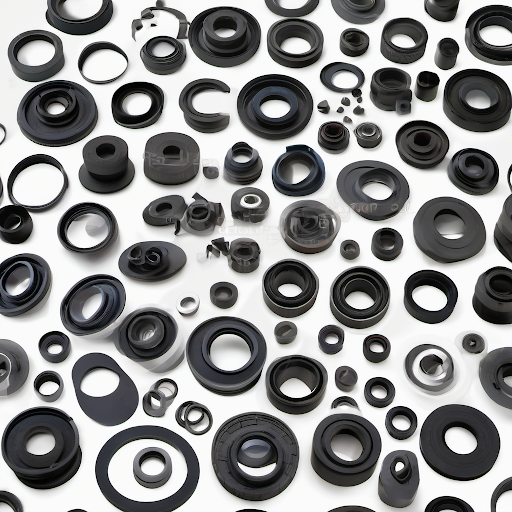
The role of rubber seals in automotive engineering is as important as other elements. These seals, playing the role of barriers, avoid leaks, contamination and also assure that each part of the vehicle that is essential is not compromised. From the engine or transmission, up to the braking system or the fluid delivery systems (all these, involves using various kinds of rubber seals), is the rubber seals that ensures efficient procedures and increases the lifespan of critical components. Saving opportunities is one of the leading contributions to performance optimization, safety deployment and overall car reliability along with reducing TCO.
Gaskets
Gaskets are versatile sealing components available in various shapes and materials to suit different applications. They are commonly made from materials like rubber, silicone, metal, or composite materials. The choice of material depends on factors such as temperature, pressure, chemical compatibility, and application requirements.
– Flat Gaskets: These gaskets have a flat surface and are used to seal static connections between two flat mating surfaces. They are often found in applications like flanged joints, heat exchangers, and machine enclosures.
– Shaped Gaskets: Shaped gaskets are designed to fit specific contours or irregular shapes, providing a custom seal for challenging applications. They are used in equipment with non-standard geometries or where a precise fit is required.
Gaskets work by compressing between the mating surfaces, creating a tight seal that prevents fluid or gas leakage. They are critical components in vital equipment such as pumps, valves, pipelines, and engines, where maintaining a leak-free environment is paramount for operational efficiency and safety.
Ensure Leak-Free Operations!
O-Rings
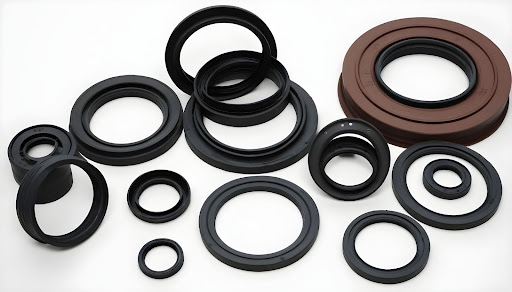
O-rings are circular elastomeric seals made from materials like rubber, silicone, or fluorocarbon. They are designed to fit into grooves or recessed areas and create dynamic seals in hydraulic and pneumatic systems. O-rings are known for their resilience, flexibility, and ability to maintain pressure integrity during operations.
In hydraulic systems, o-rings seal connections between components such as cylinders, pumps, valves, and hoses, preventing hydraulic fluid leaks and ensuring system efficiency. Similarly, in pneumatic systems, o-rings seal air or gas connections, maintaining pressure and preventing leaks that can lead to performance issues or system failures.
The design of o-rings allows them to withstand a wide range of temperatures, pressures, and fluid types, making them ideal for diverse industrial applications. Proper installation and material selection are crucial to ensure optimal performance and longevity of o-ring seals.
Optimize Pressure Integrity! Check Out Our Durable O-Rings for Hydraulic and Pneumatic Systems!
Seals
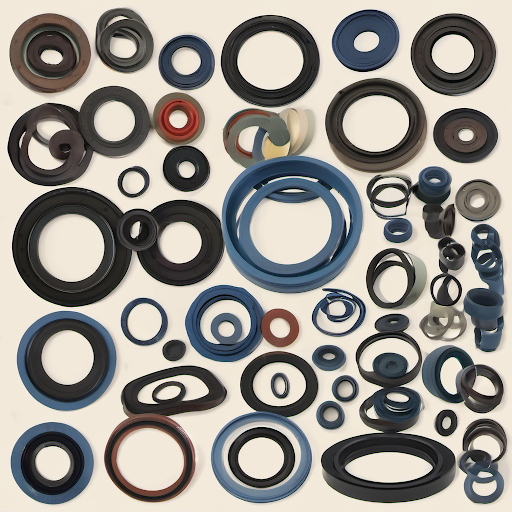
Seals are dynamic components that provide a barrier against fluid, contaminant, or lubricant ingress or egress in rotating or reciprocating machinery. They come in various forms, including lip seals, mechanical seals, labyrinth seals, and more, each designed for specific applications and operating conditions.
– Lip Seals: Lip seals, also known as shaft seals, are used to prevent lubricant leakage and contamination in rotating shafts or assemblies. They feature a lip that contacts the shaft surface, creating a barrier against fluid escape.
– Mechanical Seals: Mechanical seals are sophisticated sealing solutions used in high-pressure applications such as pumps, compressors, and turbines. They consist of stationary and rotating components that form a tight seal to prevent fluid leaks.
– Labyrinth Seals: Labyrinth seals utilize a series of chambers or grooves to create a tortuous path for fluids, effectively blocking their escape or entry. They are commonly used in rotating equipment to minimize leakage and maintain operational efficiency.
Seals are critical for equipment reliability, as they protect internal components from damage due to fluid leaks, contamination, or loss of lubrication. They require careful selection based on factors like operating conditions, speed, pressure, and fluid type to ensure optimal sealing performance.
Enhance Equipment Reliability!
Packing Materials
Packing materials, also known as packing seals or gland packing, are used in applications where a rotating or reciprocating shaft penetrates a housing or casing, such as valves, pumps, and compressors. They create a reliable seal around the shaft, preventing fluid leakage under pressure.
Common packing materials include braided or molded fibers, graphite, PTFE (Teflon), and other composite materials. These materials offer varying degrees of flexibility, resilience, and chemical resistance, making them suitable for different environments and operating conditions.
The packing installation process involves carefully wrapping or placing the packing material around the shaft and compressing it using a gland or packing nut. This compression creates a tight seal that prevents fluid leaks while allowing the shaft to rotate or move freely without excessive friction.
Regular maintenance and monitoring of packing seals are essential to detect wear, adjust compression levels, and replace worn or damaged packing material promptly. Properly installed and maintained packing seals contribute to equipment reliability, efficiency, and safety by minimizing fluid leakage and maintaining operational integrity under pressure.
Applications of Sealing Solutions
Sealing solutions find wide-ranging applications across various industries, showcasing their versatility and indispensability in critical processes. The following details delve deeper into the specific applications of sealing solutions in different sectors:
Manufacturing Industry
Sealing solutions play a vital role in the manufacturing sector, where they are used to maintain the integrity of fluid systems in machinery and equipment. They are employed in sealing hydraulic and pneumatic systems, ensuring efficient operation and preventing leaks that could lead to costly downtime. Additionally, sealing solutions are utilized in manufacturing processes that involve the handling of chemicals, ensuring safety and environmental compliance.
Automotive Sector
In the automotive industry, sealing solutions are essential for sealing engine components, transmission systems, braking systems, and fluid delivery systems. They prevent oil leaks, maintain pressure integrity, and contribute to overall vehicle performance and reliability. Seals in automotive applications must withstand varying temperatures, pressures, and environmental conditions while providing consistent sealing performance to ensure optimal functionality.
Aerospace Field
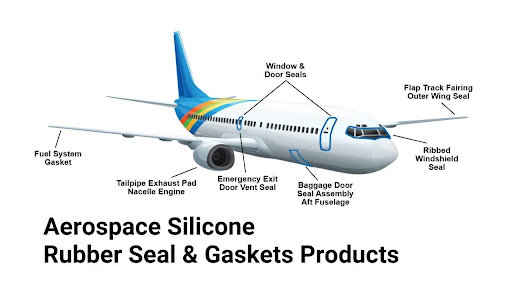
Aerospace applications demand sealing solutions that can withstand extreme conditions such as high altitudes, rapid pressure changes, and temperature differentials. Seals are used in aircraft engines, hydraulic systems, fuel tanks, and cabin pressurization systems to prevent leaks, contamination, and ensure safety during flight. The reliability and durability of sealing solutions are critical in aerospace applications to maintain flight performance and passenger safety.
Oil and Gas Industry
Sealing solutions play a crucial role in the oil and gas sector, where they are used in drilling equipment, pipelines, valves, and wellhead components. These seals must withstand harsh environments, high pressures, corrosive fluids, and temperature extremes. Proper sealing in oil and gas applications is essential to prevent leaks, ensure operational efficiency, and minimize environmental impact.
Pharmaceuticals and Biotechnology
Sealing solutions are integral in pharmaceutical and biotechnology applications, where they are used in equipment such as pumps, reactors, and filtration systems. These seals ensure containment of fluids, prevent contamination, and maintain sterility in critical processes. Sealing solutions in this sector must meet stringent regulatory standards for hygiene, safety, and product quality.
Food and Beverage Processing
Sealing solutions find extensive use in food and beverage processing equipment, where they seal fluid lines, tanks, and processing vessels. These seals must be food-grade compliant, resistant to chemical cleaning agents, and capable of maintaining hygienic conditions to prevent product contamination. Sealing solutions contribute to the efficiency, safety, and quality of food production processes.
Challenges in Sealing Industrial Machinery
While sealing solutions offer numerous benefits, they face several challenges in industrial machinery applications, necessitating innovative solutions and best practices to overcome these hurdles. The challenges include:
Chemical Compatibility
Sealing materials must be carefully selected to ensure compatibility with the fluids, chemicals, and operating conditions encountered in industrial processes. Compatibility issues can lead to material degradation, swelling, or failure, compromising the effectiveness of seals.
Temperature Extremes
Seals must withstand extreme temperature variations, ranging from freezing cold to high heat, without compromising their sealing properties. Thermal expansion and contraction can affect seal integrity, requiring materials and designs capable of handling temperature fluctuations.
Pressure Variations
Industrial machinery often operates under varying pressure levels, including high-pressure environments in hydraulic and pneumatic systems. Seals must maintain optimal sealing properties and durability under different pressure conditions to prevent leaks and ensure system efficiency.
Environmental Factors
Exposure to environmental elements such as UV radiation, moisture, chemicals, and contaminants can impact seal performance and longevity. Sealing solutions must offer resistance to environmental factors to maintain their effectiveness and reliability over time.
Explore EPDM Rubber’s Role in Green Building Trends! Learn More about Michigan’s Construction Innovations!
Dynamic Sealing Requirements
Sealing dynamic components such as pistons, shafts, and rotating assemblies presents challenges in maintaining consistent sealing performance under varying motion and operational conditions. Dynamic seals must accommodate movement while maintaining a tight seal to prevent fluid or gas leakage.
Seal Friction and Wear
Frictional forces and wear can affect seal performance over time, leading to degradation and potential failure. Sealing solutions must be designed to minimize friction, wear, and degradation to ensure long-term reliability and operational efficiency.
Addressing these challenges requires a comprehensive approach that considers material selection, design optimization, proper installation practices, regular maintenance, and monitoring of seal performance. Collaborative efforts between manufacturers, engineers, and maintenance personnel are essential to develop and implement effective sealing solutions in industrial machinery applications.
Common FAQs about Sealing Solutions for Industrial Machinery
- How do sealing solutions contribute to industrial machinery efficiency?
- What are the key differences between gaskets and o-rings?
- Can sealing solutions withstand harsh conditions?
- How often should sealing solutions be inspected and replaced?
- Are eco-friendly sealing solutions available?
- What role does installation play in seal performance?
Conclusion
Sealing solutions are indispensable assets in the realm of industrial machinery, serving as guardians of efficiency, reliability, safety, and environmental sustainability. Understanding the diverse types, applications, challenges, and maintenance requirements of these solutions is paramount for stakeholders involved in industrial operations. By adopting best practices in seal selection, design, installation, and maintenance, industrial players can optimize equipment performance, minimize downtime, and achieve operational excellence.
The manufacturing process of rubber seals is based on the technique of precision engineering rule, quality control rule and compliance to the requirement of the industry and standard to feed worthy and functional sealing solutions for automotive applications.


